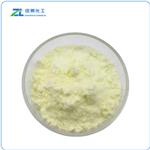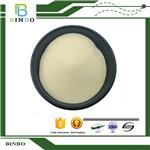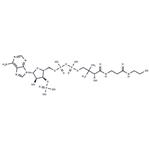
Coenzyme A
- Product NameCoenzyme A
- CAS85-61-0
- CBNumberCB8854470
- MFC21H36N7O16P3S
- MW767.53
- EINECS201-619-0
- MDL NumberMFCD06795839
- MOL File85-61-0.mol
- MSDS FileSDS
Chemical Properties
| Density | 1.96±0.1 g/cm3(Predicted) |
| storage temp. | Keep in dark place,Inert atmosphere,Store in freezer, under -20°C |
| solubility | PBS (pH 7.2): 10 mg/ml |
| form | A crystalline solid |
| pka | 9.6 (thiol); pK 6.4 (secondary phosphate); pK 4.0 (adenine NH3+) |
| color | White to light yellow |
| biological source | yeast |
| Merck | 13,2491 |
| BRN | 77809 |
| InChIKey | RGJOEKWQDUBAIZ-IBOSZNHHSA-N |
| SMILES | SCCNC(=O)CCNC(=O)[C@@H](C(COP(=O)(O)OP(=O)(O)OC[C@H]1O[C@@H](N2C3N=CN=C(N)C=3N=C2)[C@H](O)[C@@H]1OP(=O)(O)O)(C)C)O |
| LogP | -4.358 (est) |
| EWG's Food Scores | 1 |
| FDA UNII | SAA04E81UX |
| EPA Substance Registry System | Coenzyme A (85-61-0) |
| UNSPSC Code | 12352211 |
| NACRES | NA.25 |
Safety
| Symbol(GHS) |

|
|||||||||
| Signal word | Warning | |||||||||
| Hazard statements | H319-H315-H335 | |||||||||
| Precautionary statements | P264-P280-P305+P351+P338-P337+P313P-P264-P280-P302+P352-P321-P332+P313-P362 | |||||||||
| Safety Statements | 24/25 | |||||||||
| WGK Germany | 3 | |||||||||
| F | 1-10 | |||||||||
| TSCA | Yes | |||||||||
| HS Code | 2933299090 | |||||||||
| NFPA 704: |
|


